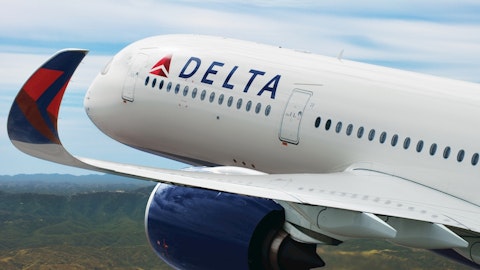American Airlines Group Inc. (NASDAQ:AAL) Q4 2023 Earnings Call Transcript January 25, 2024
American Airlines Group Inc. beats earnings expectations. Reported EPS is $0.29, expectations were $0.06. American Airlines Group Inc. isn’t one of the 30 most popular stocks among hedge funds at the end of the third quarter (see the details here).
Operator: Thank you for standing by, and welcome to American Airlines Group’s Fourth Quarter and Full Year 2023 Earnings Conference Call. At this time, all participants are in a listen-only mode. After the speakers’ presentation, there will be a question-and-answer session. [Operator Instructions] I would now like to hand the call over to Scott Long, VP of Investor Relations and Corporate Development. Please go ahead.
Scott Long: Thank you, Latif. Good morning, and welcome to the American Airlines Group fourth quarter and full year 2023 earnings conference call. On the call with prepared remarks, we have our CEO, Robert Isom; and our CFO, Devon May. A number of our other senior executives are also in the room this morning for the Q&A session. Robert will start the call with an overview of our performance, and Devon will follow with details on the fourth quarter and full year, in addition to outlining our operating plans and outlook going forward. After our prepared remarks, we’ll open the call for analyst questions, followed by questions from the media. To get in as many questions as possible, please limit yourself to one question and one follow-up.
Before we begin today, we must state that today’s call contains forward-looking statements, including statements concerning future revenues, costs, forecasts of capacity and fleet plans. These statements represent our predictions and expectations of future events, but numerous risks and uncertainties could cause actual results to differ from those projected. Information about some of these risks and uncertainties can be found in our earnings press release that was issued this morning, as well as our Form 10-Q for the quarter ended September 30, 2023. In addition, we’ll be discussing certain non-GAAP financial measures this morning, which exclude the impact of unusual items. A reconciliation of those numbers to the GAAP financial measures is included in the earnings press release, which can be found in the Investor Relations section of our website.
A webcast of this call will also be archived on our website. The information we’re giving you on the call this morning is as of today’s date, and we undertake no obligation to update the information subsequently. Thank you for your interest and for joining us this morning. And with that, I will turn the call over to our CEO, Robert Isom.
Robert Isom: Thanks, Scott, and good morning, everyone. Today, American reported an adjusted pretax profit of $257 million for the fourth quarter and approximately $2.5 billion for the full year, driven by the strength of our network, continued demand for our product and fantastic execution by our team. I want to thank the American Airlines team for their incredible work to care for our customers and deliver a 2023 that we’re proud of. We’re running a historically strong operation, driving incremental revenue through our commercial initiatives, managing our costs, producing record free cash flow and strengthening our balance sheet through debt reduction. This year, we’ll continue to prioritize reliability, profitability and accountability, while building an even more efficient and resilient airline.
We also remain focused on taking care of our team and continue to make progress on our labor agreements. Our commitment in negotiations has been consistent, reach deals as quickly as possible and ensure our team is paid as well as their industry peers. We finalized a new contract with the APA in the third quarter last year. And a few weeks ago, we did the same for our customer service team, represented by the CWA-IBT, giving team members increased pay and quality of life improvements. We continue to negotiate with the APSA with the shared goal of reaching a deal that will pay our flight attendants at the top of the industry. Now, let’s talk more about our financial results. We produced record full year revenues of approximately $53 billion, driven by strong demand for our product and record revenue from our travel rewards program.
Demand remains strong, and we’ve seen robust bookings to start the year as travel trends have begun to normalize across entities. We’re also very encouraged by the trends we’re seeing in business travel. Domestic revenues from business travel ended the fourth quarter at approximately 90% of 2019 levels. We’re excited about the continued rollout of the AAdvantage Business program, and we continue to see strength among small and medium-sized businesses. We see further potential revenue upside as we restore our hubs domestically, enabled in part by the recovery and regional supportability. This year, we expect our system capacity growth to be balanced between domestic and international. More than ever, our revenue growth is fueled by a growing number of AAdvantage customers who acquired our co-brand credit cards in record numbers in 2023.
AAdvantage customers represent both our greatest source of value and greatest opportunity going forward. In 2023, two-thirds of our revenue came from AAdvantage customers. These customers also account for 70% of our upsell, loyalty and partnership revenue. Over the past year, we have made changes to our distribution strategy to give customers direct, improved access to our best products and enable American to provide better customer service to the individual traveler. We’re very encouraged by the results. Customers who shop directly with us have a more enjoyable experience and are 11 points more likely to recommend American than those shopping in traditional outlets. They’re purchasing more valuable content and doing so at lower expense. In 2023, our revenue was 15% higher than 2019, while our selling expenses were 10% lower.
Our fleet, network and travel rewards program will continue to drive significant value moving forward. And our limited near-term capital requirements will position us to continue to generate free cash flow. Turning now to the operation. The American Airlines team continues to achieve industry leading operational results. We produced our best ever performance in the fourth quarter and over the full year, including our record on-time departure rate and completion factor during the busy holiday season. American ranked first among the U.S. network carriers in mainline and regional completion factor in 2023, with our lowest number of cancellations for any year since the merger. All of this led to record likelihood to recommend scores in the fourth quarter and full year.

No network airline has operated more reliably than American over the past year and a half. We’re running the best operation in our history, thanks to our focus on operational excellence and strong collaboration across the entire organization. We will continue to build on that performance and deliver exceptional service for our customers. Now, I will turn it over to Devon to share more about our fourth quarter and full year financial results and outlook for the rest of the year.
Devon May: Thank you, Robert, and thank you to the American Airlines team for continuing to produce outstanding results. In the fourth quarter and for the full year, we delivered a fantastic operation for our customers. We took further action to strengthen our balance sheet. And early this year, we finalized a new contract for our customer service team members. In the fourth quarter, excluding net special items, we reported net income of $192 million or adjusted earnings per diluted share of $0.29, and earnings results above our guidance for the quarter, driven by strong operational performance and better ex-fuel unit cost performance. For the full year, we delivered on our stated objectives and produced results in line with the guidance we provided last January, including on-capacity production, unit revenue, CASMx and earnings per share.
Excluding net special items, we generated full year net income of $1.9 billion, or adjusted earnings per diluted share of $2.65. And importantly, for the full year, we generated free cash flow of $1.8 billion. In 2023, American produced record revenue of approximately $53 billion. We generated an adjusted EBITDAR margin of 14.5%, and an adjusted operating margin of 7.6%. In the fourth quarter, revenue was more than $13 billion. Our adjusted EBITDAR margin was 12%, and we produced an adjusted operating margin of 5.1%. Our strong operational performance in the fourth quarter resulted in capacity that was 5.8% higher year-over-year, slightly above the midpoint of our guidance range. Unit revenue for the quarter was in line with the midpoint of our previous guidance, down 6.4% year-over-year.
Unit cost, excluding net special items and fuel, was up 4.2% year-over-year, nearly 1 point better than the low end of our prior guidance range. This outcome was driven in part by the strength of our operation, resulting in more capacity, lower overtime and premium pay and lower interrupted trip expense. Turning now to our fleet. We have modest aircraft CapEx requirements this decade due to the fleet investments we made over the past decade. In 2023, we took delivery of 23 new mainline aircraft. This year, we expect to take delivery of 28 new mainline aircraft, including 20 737 MAX 8, six 787-9 and two A321neo aircraft. Our 2024 aircraft CapEx is expected to be approximately $2.3 billion, and our 2024 non-aircraft CapEx is expected to be approximately $850 million.
We continue to have discussions with manufacturers for additional aircraft to deliver later this decade and into the 2030s. Due to the young age of our fleet, we have very modest aircraft replacement needs. As a result, we expect aircraft capex to average less than $3.5 billion per year from 2025 through 2030. A relatively low capital requirements, along with our free cash flow production has allowed for significant progress in strengthening the balance sheet. We have now reduced total debt by approximately $11.4 billion from peak levels in 2021. And by the end of this year, we expect to have reduced total debt by approximately $13 billion from peak levels in 2021, which is over 85% of the way towards our $15 billion total debt reduction goal.
Now onto the outlook for 2024. Our focus this year will be to continue to deliver industry-leading reliability and to reengineer our business to ensure we run the airline as efficiently as possible while enhancing the customer experience. This year, we’ll finally be producing more capacity than we did in 2019. Consistent with our prior expectations, we plan to grow capacity mid-single digits year-over-year in 2024. This growth will be enabled by improved asset utilization and new aircraft deliveries. Based on current assumptions, we expect full year TRASM to be flat to down 3% year-over-year. For the full year, we expect CASMx to be up approximately 0.5% to 3.5% versus 2023. This unit cost guidance reflects approximately 2.5 points of year-over-year CASMx pressure due to collective bargaining agreements ratified in 2023 and early 2024, and anticipated agreement with our flight attendants in 2024.
Our ability to achieve this full year unit cost result is due to our focus on operating more efficiently and improving our asset utilization. In 2024, we expect aircraft utilization to be up 2% to 4%, and we expect to deliver approximately $400 million in cost savings through the use of digital solutions, reengineering processes and transforming procurement. We have spent the last 18 months sizing the opportunity and developing plans to reengineer our business to be more productive, while improving the customer and team member experience. We are excited about the early results, and we will spend more time discussing these opportunities in greater detail at our upcoming Investor Day. This year, we expect to produce adjusted earnings per diluted share of between $2.25 and $3.25.
Using the midpoint of that guidance, we are forecasting free cash flow production of over $2 billion. Looking at the first quarter, we expect TRASM to be down approximately 3.5% to 5.5% on 6.5% to 8.5% more capacity year-over-year. We expect first quarter CASMx to be up approximately 2% to 4% year-over-year. Recall that we did not have the cost impact of our new pilot agreement accrued in the first quarter of 2023. Our year-over-year CASMx performance improved throughout the year as we lap the pilot agreement increases. Our current forecast for the first quarter assumes a fuel price of between $2.65 and $2.85 per gallon. Based on our current demand assumptions and fuel price forecast, we expect to produce an adjusted operating margin of between 0% and 2% in the first quarter, and an adjusted loss per share between $0.15 and $0.35.
We are pleased with the progress the American Airlines team has made in 2023, and we remain focused on delivering results to unlock additional value in 2024 and beyond. Now back to Robert for closing remarks.
Robert Isom: Thanks, Devon. The American Airlines team continues to produce outstanding operational and financial results. When I moved into the CEO role two years ago, we made a commitment to be reliable and profitable and we have delivered in a big way. We made it clear to all of you what we were going to do and our team made it happen. Moving forward, we will continue to execute on our plans and control what we can control. Our team has done tremendous work, but there is much more in front of us as we continue to leverage our fleet and our network and build on our operational momentum. We see significant opportunistic to reengineer the business to build a more efficient airline. All of this will enable us to generate sustainable free cash flow. We look forward to sharing much more at our Investor Day on March 4th. And now, operator, please open the line for analyst questions.
See also 20 Countries with the Lowest Minimum Wage in the World and 10 Best Tech Stocks for the Next 5 Years.
Q&A Session
Follow American Airlines Group Inc. (NASDAQ:AAL)
Follow American Airlines Group Inc. (NASDAQ:AAL)
Operator: [Operator Instructions] First question comes from the line of Michael Linenberg of Deutsche Bank.
Michael Linenberg: Hey. Thanks. Good morning, everyone. I guess sort of a two-part question to involve Latin America too, I guess, Vasu. December quarter, it did look like that, that was the geography that underperformed, and I know some have called out that that’s going to be a challenging geography in the March quarter as well. Obviously, it’s a region that you’re very strong in. I believe last quarter, Vasu, you did indicate that you were sort of going to add even more capacity into the region. There were markets that maybe were working there. Can you differentiate between near international beach markets and maybe Latin America long haul? Is there a distinction? One’s outperforming the other. Any color on that? And then I have a quick follow-up related to the region as well. Thank you.
Vasu Raja: Absolutely, Mike. No, it’s a great question. There’s actually two things to clarify. One is the difference between, as we call it short haul and long haul Latin America and also the difference between year-over-year RASM and actually, marginal profitability. So — and I’ll do the second one first. First, in December, we flew our largest schedule ever in Miami with so much of it going to Latin America. It also was most profitable we’ve seen the Miami hub. We’ve been able to drive a lot of efficiency over South America. And so while we do see some more challenging near-term revenue trends, the important thing is, it’s near term both in short and in long. As we look at Q1, the entirety of our short-haul business, domestic plus the short-haul Latin markets together, basically, any way where we can fly a narrow body turns positive by the end of Q1.
So, we do see the issues as really more near term. And related with — in the long-haul market too, we see improving trends as we move through the course of the year.
Michael Linenberg: Okay. Great. And then just my second on Latin America. Your partner down in Brazil, looks like they may potentially file for bankruptcy. When I think about your CapEx and investments for 2024, are you including in that some potential additional investment in GOL or is that a TBD or maybe that’s not even on the table? How should we think about that and your relationship there?
Vasu Raja: Hey, Mike. There’s probably a lot about this that we’re not going to quite answer yet, but at least, let me offer this. First, foremost and always, our partnership with GOL is a commercial partnership and we benefit them tremendously through our network, our AAdvantage program and our customer base. We’re a massive source of value for them. And whatever course of action they choose to take, that will hold true. And the last thing I’ll say is really for our customers that no matter what might happen in the region, we see no compromise to our network connectivity, the quality of service or whatever else might be the case. So, we’re prepared for all eventualities, but our partnerships are first and foremost, commercial partnerships.
Operator: Thank you. Our next question comes from the line of Scott Group of Wolfe Research.
Scott Group: Hey. Thanks. Good morning. So, overall, we’ve seen some of the other airlines so far guide to positive RASM this year . How come you guys are so flat? You guys are flat to down on RASM. Any thoughts that explains the difference between what you’re guiding to and maybe what some of the others are saying?
Robert Isom: Thanks, Scott. Hey, look, we see, obviously, a tremendous demand. But we build our plan based on what we think is going to happen. Now that said, if other carriers are actually seeing that kind of benefit, it’s going to accrue to American as well. And so I have no doubt that if there are adjustments to our assumptions based on any reason, whether that be capacity or demand that, look, we’re going to be the beneficiaries as well as for overall economic performance in the U.S.
Devon May: Yeah. And, Scott, I’ll only add, our focus in this company is margin performance. And there is so much that can change as you get out into Q3 or Q4. But as we see it right now, as the year has started, we are intaking revenues at the same growth rate that our capacity is coming in. As I mentioned earlier, we will exit Q1 as we anticipated with positive year-over-year RASM in our domestic and short-haul business. And we expect a lot of the same strength in international RASMs to continue. But first and always, we are margin focused.
Scott Group: So, just — so I understand within your RASM guide for Q1, you’re expecting domestic RASM to inflect positive by the end of the quarter. Is that right?
Devon May: Correct.
Scott Group: Okay. And then just so I heard — just want to clarify then. The full year guide does include expectations for a flight attendant deal.
Robert Isom: Yes. It does have an assumed flight attendant deal.
Scott Group: Okay. All right. Thank you, guys. Appreciate the time.
Operator: Thank you. Our next question comes from the line of Catherine O’Brien of Goldman Sachs. Your question, please, Catherine?
Catherine O’Brien: Hey. Good morning, team. Maybe one for Devon first. Congrats on the progress towards your total debt goal. It seems like that’s tracking ahead of schedule. What’s the right debt reduction target we should be thinking about for 2024 with over $2 billion in free cash flow currently expected? I’m sure we’ll hear more in March, but any high level thoughts on where you want leverage to go in the short term? And what’s the appropriate long-term level of net debt or EBITDAR, or whatever your preferred metric is? Thanks so much.
Devon May: Hey. Thanks for the question, Catie. We are pretty focused on the next 24 months right now. So as we mentioned in the prepared remarks, we expect total debt reduction to be down $13 billion by the end of 2024, so about $1.5 billion improvement from where we were at, at the end of 2023. We still have a target for $15 billion of total debt reduction by the end of 2025. So, we’re really proud of the progress we have made over the last couple of years. Also, really proud of the progress we’ve made in smoothing out our debt towers going forward. At the start of 2023, we had over $9 billion of debt due in 2025. Through debt paydown and some refinancings, we have significantly smoothed that tower and we feel really good about where we’re at now. Still feel great about the $15 billion total debt reduction target. And yeah, as we get to the Investor Day in March, we’ll talk a lot more about our longer term goals for the balance sheet





